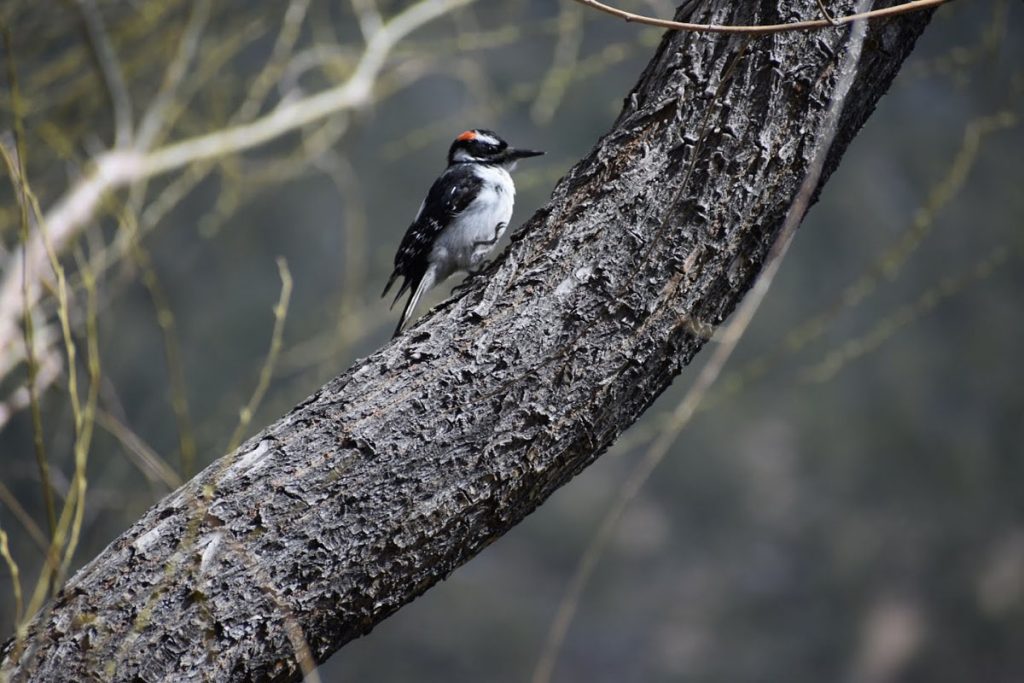
While other birds greet the morning with song, woodpeckers provide the beat, rapidly drumming against bark and sending rhythmic echoes through the air. They aren’t looking for food, though—in fact, foraging for insects is a quiet activity. These woodpeckers are fulfilling their namesake as a means of marking their territory, letting other members of their species know that they’ve staked out this tree as their own.
Widely dispersed across most of the U.S. and the southern half of Canada, downy woodpeckers are the smallest species of woodpecker in North America and one of the most common, with a population estimated at 13 million. They’re easily identifiable by their size, measuring just 18 cm (or 7 inches) in height at most, and weighing in at around 30 grams, with a distinctive black and white color scheme. Their wings look as if someone flicked a wet paintbrush on them—all black with white dots. Males carry the iconic red woodpecker crest on their heads. Distinguishing a downy woodpecker from a hairy woodpecker is where it gets tricky, as they share a similar size and colorings, but the downy woodpecker is identified by its white tailfeather spots and a bill that’s shorter than its head.
The beak of a woodpecker is made up of three layers that allow it to hammer and bore into trees without concussing themselves. The outer layer is composed of interlocked keratin scales, the middle is made up of porous foam, and the innermost layer is solid bone. The downy woodpecker has an additional advantage not found in all woodpecker species, a little tuft of feathers on its beak that prevent stray debris from entering its nostrils while it’s at work.
Once a hole has been bored, the woodpecker uses its long tongue to rake out insects from within. Downy woodpeckers eat a lot of bugs: in fact three-quarters of their diet consists of insects and their larvae, with the remainder made up of nuts, berries, and grain.
Their tongue is another marvel of adaptation. It is so long that it wraps around the woodpecker’s skull and gives additional shock absorption! It’s coated in a sticky saliva that makes catching food that much easier. Pests like the bark beetle or invasive European corn borer moth are kept in check by the downy woodpeckers, with one study showing they reduced the population of codling moths, a threat to orchards, by 52 percent.
During mating season, the downy woodpeckers form monogamous pairs and lay broods of four to five eggs. Both parents incubate the eggs and take turns foraging for food and drumming on the tree to mark their territory. Because of their small size, downy woodpeckers have more real estate available to them and can build nest cavities with openings as small as 10 cm around, giving great protection from predators. Dead or dying trees are their preferred homes, especially those infected by fungus or covered in lichen, which gives additional camouflage. Eggs are incubated for 12 days, and the fledglings are ready to leave after a month or so. Despite their small size, these woodpeckers can live upwards of a decade—one male downy woodpecker tagged in 1985 was recaptured in 1996 and then released again!
If you want to attract downy woodpeckers to your yard, they love peanut butter suet and black oil sunflower seeds. Nest boxes can be placed at least six feet above ground with a small layer of wood shavings on the floor to attract couples.
There’s a pastoral feeling to waking up in the morning to the sound of a woodpecker vigorously pecking away. They are nature’s drummers, adding percussion to the chorus of birdsong.
Author
-

Bryce Flanagan moved from Sacramento, CA to Taos County in 2016, and has lived in Questa for two years. He's passionate about the unique and beautiful wildlife of our state and is a regular contributor to the Questa Del Rio News.
View all posts



